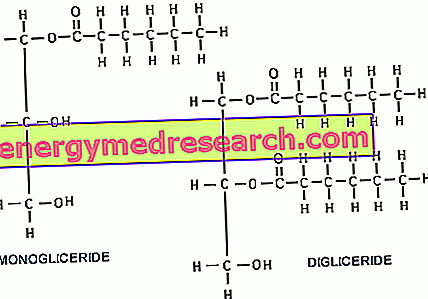The mono and diglycerides of fatty acids are nutrients well known to our body, which receives them through nutrition both directly and indirectly (from hydrolyzed triglycerides during the digestive processes). Recall that the most abundant lipids in nature are precisely the triglycerides, hydrophobic molecules (not soluble in water) formed by the union of three fatty acids with a glycerol molecule. If we remove one or two fatty acids from this structure, we obtain the mono and diglycerides of fatty acids.


Unlike fatty acids, glycerol is a water-soluble molecule. It follows that by subtracting one or two fatty acids from the structure of a triglyceride, the water solubility of the lipid increases considerably. This feature is useful in the industrial field, where the mono and diglycerides of fatty acids (E471) are mainly used as emulsifiers, therefore for their ability to keep "united" aqueous phases (water - thanks to OH of glycerol) with oily phases (oil - thanks to fatty acids). In this regard, it has been known for many years that special mixtures of mono and diglycerides of fatty acids have a superior emulsifying power compared to single compounds. Generally, esters of saturated and unsaturated fatty acids are used with carbon chains that exceed 16 carbon atoms.
Mono and diglycerides of fatty acids are naturally formed in the process of rancidity, so much so that in oils the maximum content of free fatty acids is regulated by law (also because they give the product a decidedly unpleasant taste). In the industrial field, these additives are produced synthetically from glycerol and from single fatty acids, or obtained from by-products of the oil industry.
Since it is not possible to ascertain a priori the type of fatty acids linked to glycerol, therefore knowing the percentages of saturated, unsaturated and hydrogenated fatty acids, we cannot formulate a precise health judgment on these additives. These are obviously safe substances, given their normal presence in food and the continuous origin of the digestive processes on triglycerides. The health impact remains doubtful, given that in theory for functional requirements a producer of a food without hydrogenated fats could then use mixtures of mono and diglycerides rich in trans fatty acids. Even if mainly vegetable oils are used, the use of animal fats cannot be excluded.
Other widely used additives are the esters of the mono and diglycerides of fatty acids, in which the free hydroxyl groups of glycerol are esterified with acetic acid, lactic acid, citric acid, tartaric acid or combinations thereof. These additives (E 472 a, b, c, d, e, f) are used - due to their emulsifying and stabilizing capacity - above all in cheese products such as bread, breadsticks and rusks.



